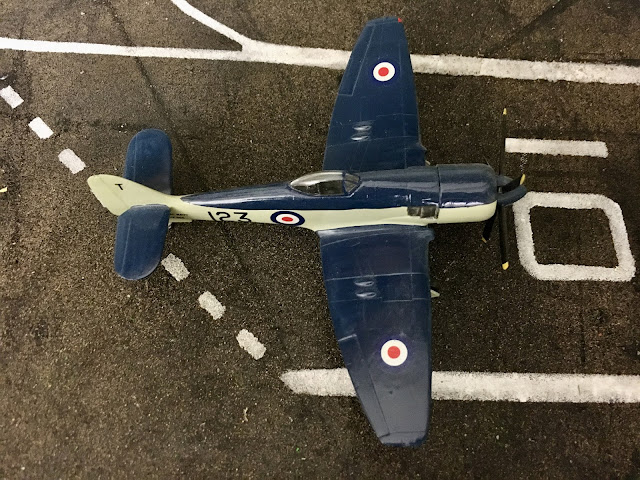Last week you may recall me noting that while the RAF took no aircraft to Korea, the Royal Navy's Fleet Air Arm turned up in force. Supermarine Seafires, Hawker Sea Furies and Fairey Fireflies from Royal Navy aircraft carriers provided the only British air combat contribution to the Korean War. So, in my back catalogue of 1:76 scale models, I'm pleased to have my 2008/09 construction of what I think was a PM Model's Hawker Sea Fury FB.11. I say "I think" because it is the only scale model company I can find having released a Sea Fury in the markings I have on my model, and this was before I started improvising!
So, not unsurprisingly, I don't remember much of the build itself, although it looks very simple, of few detailed pieces and, observing the empty canopy, I have a vague memory of it lacking a pilot figure as well, so I had to go for that parked up unattended look! Overall my feeling is that it was a disappointing build of a kit from a lesser known producer, making me even more convinced it's PM Models work. In the end, it was probably just an important addition to my Korean War model collection, one of the British few.
 |
| My Hawker Sea Fury awaits its pilot for takeoff! |
Following the outbreak of the Korean War on 25th June 1950, Sea Furies were dispatched to the region as part of the British Commonwealth Forces Korea, Britain’s contribution to the United Nations multinational task force, to assist South Korea following an invasion by North Korea. Sea Furies were flown throughout the 3 year conflict, primarily as ground-attack aircraft, from the Royal Navy's light fleet carriers: HMS Glory, HMS Theseus, HMS Ocean, and the Australian carrier HMAS Sydney.
After a Fleet Air Arm Seafire was shot down by a United States Air Force Boeing B-29 Superfortress on 28th July 1950, all Commonwealth aircraft were painted with black and white Invasion stripes as first used 6 years earlier during and post the D-Day landings of 1944. I wonder if I balked at the time of painting these stripes on my model, a task I later relished when building my lockdown D-Day inspired Hawker Typhoon.
 |
| Probably how my model should have looked |
The role of British airpower in the Korean War was small but vital, and the Hawker Sea Fury established a unique record during the conflict. The Sea Fury was the last propeller driven fighter in service with the Royal Navy. It also has the distinction of being the fastest single piston engine aircraft on record with a maximum speed of 460mph, 50mph faster than even last week's jet fighter, the Gloster Meteor! Initially put into production in 1945, the Sea Fury saw service throughout the Korean War, proving itself as an effective carrier defence fighter when it set a unique record during the conflict. On August 8th, 1952, a Sea Fury piloted by Lt. Peter 'Hoagy' Carmichael of 802 NAS, launched from HMS Ocean, became one of the few propeller driven aircraft to shoot down a jet fighter, a MiG-15, in combat.
 |
| How I wished I'd painted my model! |
Although the Sea Fury was retired by the majority of its military operators in the late 1950s in favour of jet-propelled aircraft, a considerable number of aircraft saw subsequent use in the civil sector. Several remain airworthy today as heritage aircraft, while a number were snapped up for air racing in the United States where they set world speed records. See the above picture.
 |
| Hawker Sea Fury taking off from HMS Ocean in Korea 1952 |
Finally, the above photo of a Hawker Sea Fury taking off from HMS Ocean Korea 1952 definitely lacks the Invasion stripes which were reportedly added in 1950, so either the date is wrong or maybe the stripes were dropped later in the war ... more research required!
----
.. and may be the model in the markings of the Royal Navy Historical Flight Yeovilton




No comments:
Post a Comment
Note: only a member of this blog may post a comment.